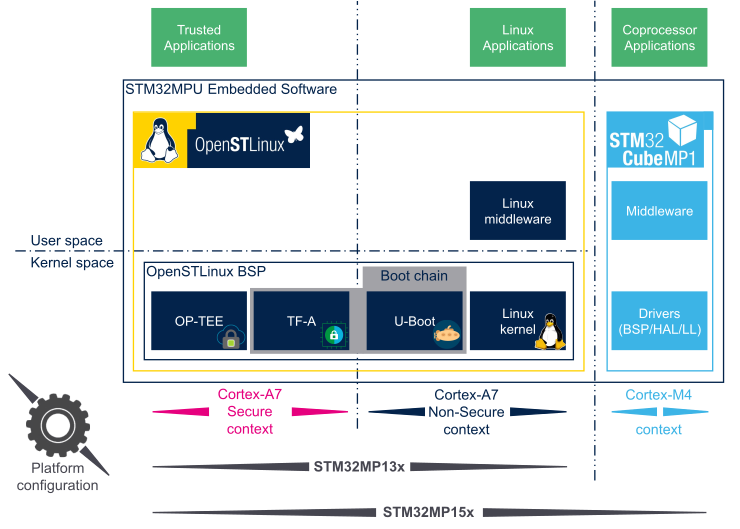Registered User mNo edit summary |
Registered User |
||
| Line 6: | Line 6: | ||
*** The [[OP-TEE overview|OP-TEE ]] secure OS running on the Arm<sup>®</sup> Cortex<sup>®</sup>-A in secure mode. | *** The [[OP-TEE overview|OP-TEE ]] secure OS running on the Arm<sup>®</sup> Cortex<sup>®</sup>-A in secure mode. | ||
*** The '''Linux<sup>®</sup> kernel''' running on the Arm<sup>®</sup> Cortex<sup>®</sup>-A in non-secure mode. | *** The '''Linux<sup>®</sup> kernel''' running on the Arm<sup>®</sup> Cortex<sup>®</sup>-A in non-secure mode. | ||
** The '''application frameworks''' are composed of middlewares relying on the BSP and providing API | ** The '''application frameworks''' are composed of middlewares relying on the BSP and providing API, on '''Linux''' side, to run '''Applications''' that typically interact with the user via the display, the touchscreen, etc. | ||
** On '''OP-TEE''' side, the '''Trusted Applications (TA)''' relies on the OP-TEE core for secrets operations (not visible from the Linux and STM32Cube MPU Package) | |||
** | |||
* The '''STM32Cube MPU Package''' is running on the Arm<sup>®</sup> Cortex<sup>®</sup>-M: it is based on HAL drivers and middlewares, like other STM32 microcontrollers, completed with [[Coprocessor_management_overview|coprocessor management]].<br /> | * The '''STM32Cube MPU Package''' is running on the Arm<sup>®</sup> Cortex<sup>®</sup>-M: it is based on HAL drivers and middlewares, like other STM32 microcontrollers, completed with [[Coprocessor_management_overview|coprocessor management]].<br /> | ||
The figure below is clickable so that the user can directly jump to one of the sub-levels listed above.<br /> | The figure below is clickable so that the user can directly jump to one of the sub-levels listed above.<br /> | ||
| Line 26: | Line 25: | ||
[[File:OpenSTLinux OE legend.png|center]] | [[File:OpenSTLinux OE legend.png|center]] | ||
<br /> | <br /> | ||
== Open Source Software (OSS) philosophy == | == Open Source Software (OSS) philosophy == | ||
The '''Open source software''' source code is released under a license in which the copyright holder grants users the rights to study, change and distribute the software to anyone and for any purpose<ref>https://en.wikipedia.org/wiki/Open-source_software</ref>. | The '''Open source software''' source code is released under a license in which the copyright holder grants users the rights to study, change and distribute the software to anyone and for any purpose<ref>https://en.wikipedia.org/wiki/Open-source_software</ref>. | ||
Revision as of 13:07, 12 March 2021
1. STM32MPU Embedded Software overview
The diagram below shows STM32MPU Embedded Software distribution main components:
- The OpenSTLinux distribution, running on the Arm® Cortex®-A, including:
- The OpenSTLinux BSP with:
- The boot chain based on TF-A and U-Boot.
- The OP-TEE secure OS running on the Arm® Cortex®-A in secure mode.
- The Linux® kernel running on the Arm® Cortex®-A in non-secure mode.
- The application frameworks are composed of middlewares relying on the BSP and providing API, on Linux side, to run Applications that typically interact with the user via the display, the touchscreen, etc.
- On OP-TEE side, the Trusted Applications (TA) relies on the OP-TEE core for secrets operations (not visible from the Linux and STM32Cube MPU Package)
- The OpenSTLinux BSP with:
- The STM32Cube MPU Package is running on the Arm® Cortex®-M: it is based on HAL drivers and middlewares, like other STM32 microcontrollers, completed with coprocessor management.
The figure below is clickable so that the user can directly jump to one of the sub-levels listed above.


- STM32CubeMP1 architecture
- OP-TEE overview
- TF-A overview
- U-Boot overview
- STM32MP15 Linux kernel overview
- Boot chain overview
- Linux application frameworks overview
- OpenSTLinux BSP architecture overview
- OpenSTLinux architecture overview
- Category:Platform configuration
- Security overview
2. Open Source Software (OSS) philosophy
The Open source software source code is released under a license in which the copyright holder grants users the rights to study, change and distribute the software to anyone and for any purpose[1].
STMicroelectronics maximizes the using of open source software and contributes to those communities. Notice that, due to the software review life cycle, it can take some time before getting all developments accepted in the communities, so STMicroelectronics can also temporarily provide some source code on github[2], until it is merged in the targeted repository.
3. References
